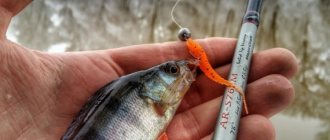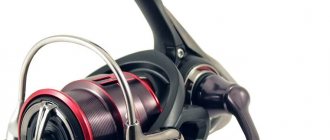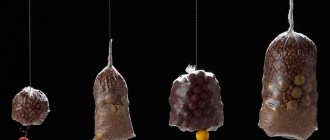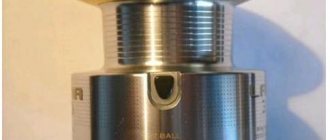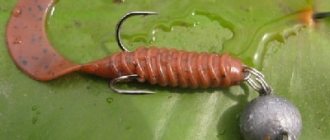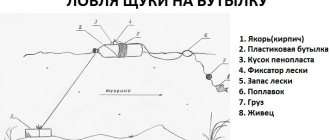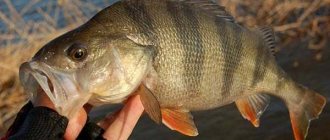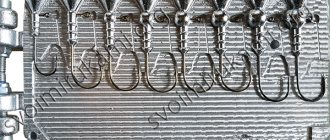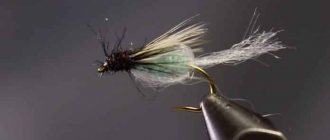Spinning fishing is one of the most popular areas of modern amateur and sport fishing. In contrast to float and bottom fishing, spinning gear is characterized by a highly dynamic hunting, with frequent changes in fishing locations and constant movements of the fisherman across promising areas. Fishing strategies involve catching not only predatory fish species, but also a fairly wide range of representatives from the peaceful population of our freshwater ichthyofauna.
It is possible to catch fish with a spinning rod on reservoirs of various structures, and for these purposes today there is a decent selection of artificial baits that differ in their operating principles. Assembling spinning gear will not cause any particular difficulties, since fishing stores offer a lot of types of specialized fishing rods that differ from each other in operating parameters and characteristics, selected for the upcoming fishing conditions. The technique of fishing itself is mastered quickly, since various styles of animation of baits differ in the complexity of execution, starting from the elementary uniform movements of a classic spinner, with which almost all beginners begin, and ending with the intricate play of a wobbler, which is within the power of an already experienced spinning player.
Spinning fishing for beginners will require a little theoretical training in terms of the ability to assemble effective tackle, correctly determine a promising hunting location and become familiar with the technique of casting and guiding the bait chosen for fishing. The article presented to the fisherman will reveal these basic issues, making it easier for the young spinning angler to quickly master this interesting and productive type of fishing.
How to choose the optimal fishing rod
The basics of spinning fishing begin with the ability to choose the right tackle, which will become a fundamental element in assembling the tool. For effective selection, they are guided by a number of conditions in which fishing will be carried out. In particular, the angler must imagine where he will cast from, from shorelines or fish water areas from a boat.
Fishing from coastlines is often complicated by all kinds of vegetation that hinders casting, which is also important to take into account when choosing gear. For fishing from a boat and in conditions of overgrown banks, short rods up to 2.1 meters are used, and when fishing from bridges and clean banks, long gear up to 3.5 meters is used. For dynamic fishing that does not put strain on your hands, it is better to choose carbon fiber gear or blanks made from composite materials. Based on the type of assembly, plug-in gear is most convenient.
Based on the parameters of the bait used, its weight and style of play, the characteristics of the rod such as test and action are determined. The test parameter gives a range of limits for the optimal mass of baits acceptable when fishing with the selected gear. The structure indicates the rigidity of the form, which affects the information content of the gear and the clarity of bait control. Hard or fast fishing rods are much more effective at hooking fish and animating simulators, but practically do not absorb excess loads from jerks of the trophy. Soft ones, on the contrary, are less informative, but comfortable for fishing. When fishing with a spinning rod for beginners, it would be better to start with the purchase of a medium and more universal fishing rod, which allows you to feel the operation of the equipment, gaining an initial stable skill in mastering the technique of casting, retrieving and landing fish.
Rod selection
Nowadays there are a huge number of different spinning rods on sale, and understanding them is not at all easy. In order for everything to fall into place, we will analyze each aspect. Well, if you don’t have time to delve into the intricacies, go down to the conclusion section, the best tackle has already been selected there.
Type of rod
Initially, spinning rods can be divided into three types:
- Telescopic – Compact rods usually consist of a two-piece handle and a telescopic part, but there are also one-piece models. These rods have quite a few disadvantages; these forms are quite hard and fragile. The joints of the knees wear out quickly, and assembling such equipment takes a lot of time.
- Plug spinning rods are the most popular rods among spinning anglers. The only downside is the inconvenience of transportation, everything else is just pluses.
- Solid rods – Small blanks, usually about a meter long and with ideal bait sensitivity. Most often used for fishing on small rivers and streams, where long casting is not required.
For beginners, the best option would be a plug-in spinning rod, as it is a universal and unpretentious option.
Material
All fishing rods are made from three types of material:
- Fiberglass - Cheap, rigid and heavy, although quite durable models are suitable only for making donuts. With this rod you won’t feel the bait, so we don’t choose these models.
- Graphite (carbon) – Quite expensive and fragile spinning rods. Thanks to the material, they are lightweight and have excellent sensitivity. If you choose this material, be careful when casting the bait and transporting it; hitting the tip with the spoon can lead to breakage.
- Composite fishing rods - Made from the two above materials, therefore they are the golden mean. Thanks to the combination of fiberglass and carbon fiber (graphite), it was possible to significantly reduce the cost of the rod without losing almost any sensitivity and lightness.
For beginners, it is best to choose composite spinning rods. They are quite sensitive, forgive many mistakes when casting, and are not as expensive as graphite ones.
When purchasing, be guided by the price of the form. Graphite rods cannot be cheap! If in front of you lies a spinning rod for 1000 rubles with the proud inscription “Graphite”, know that this is a composite rod.
Test
Another interesting parameter that indicates the weight range of the baits used. This parameter gave the names to the classes of rods:
- Ultralight (UL Marking) – Lightweight spinning rods with a weight of up to 10 grams are suitable for delicate fishing for small (sometimes even peaceful) fish in the coastal zone. The maximum casting distance is about 20 meters.
- Light (Marking L) – Spinning rods for fishing in the coastal zone with bait weighing up to 15 grams. Well suited for catching small grass pike and medium perch. The maximum cast is approximately 35 meters.
- Middle class (medium (Marking M)) – Rods for fishing at medium distances. They have a weight of up to 30 grams and are suitable for catching any predatory fish using various baits. These rods are universal, since their lower weight limit is 7 grams, and this already allows you to fish near the shore.
- Heavy (Marking H) – Used for catching trophy fish such as catfish. Has a test of 40 grams and above.
You can also find rods marked ML and MH. These are intermediate classes, medium light and medium heavy. Different manufacturers may shift these boundaries, so when choosing, focus only on grams.
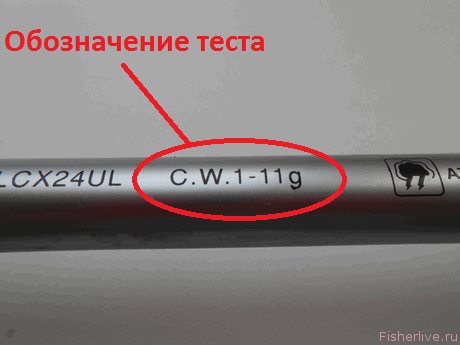
For beginner anglers, mid-class rods are best, although some start with a light one.
Length and action
Here everything is much simpler, everyone understands the length, but the structure is nothing more than the amplitude of the bending of the spinning rod under load. Rods can be divided into 4 types of action:
- Very fast – only the tip of the working part of the rod bends
- Fast – 2/4 of the working part of the spinning rod bends
- Medium – ¾ of the working part of the rod bends
- Slow – The entire working part bends
Let us briefly examine the pros and cons of the two extreme systems:
- Very fast action - Pros : Casting accuracy, high-quality hooking, strength, sensitivity. Disadvantages : The baits are not thrown far, the bait can be torn off when hooking, and when fishing, it may slip due to low shock absorption.
- Slow action - Pros : Long casting, good shock absorption when fishing, taking into account the softness, the possibility of using thinner lines. Cons : Casting is not accurate, delay when hooking, low sensitivity.
Beginner fishermen need to learn to feel the bait, but since mistakes
inevitable, it is best to choose a fast action when 2/4 of the rod bends. Determining the action is quite simple, you need to take the rod and simulate casting, that is, swing it.
So you will understand what kind of system it is, if the tip bent forward (or not bent at all) and immediately fell into place, this is a very fast system. If the tip bends forward, moves back and takes its position, this is a fast formation, that is, what we need.
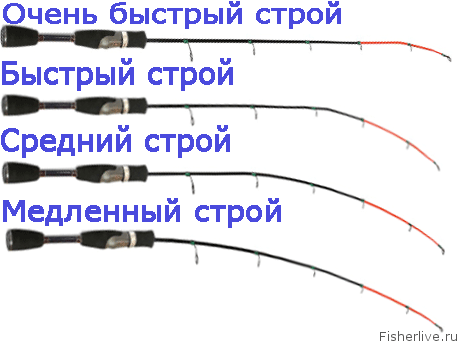
The length of the rod is selected depending on how you will fish from a boat or from the shore. For fishing from a boat, forms up to 2.5 meters long are suitable. Anything longer is simply not rational, firstly it will be inconvenient, and secondly, when hooked, you can swim up and unhook the bait.
When fishing from the shore, there is no way to swim up to the bait (although there is, but... :)), so you will have to navigate around various obstacles in the form of water lilies or bushes using a fishing rod. To avoid unnecessary body movements, choose a spinning rod with a length of 2.6 to 2.8 meters.
With such a rod it will be easy to control the wiring, and if the line overlaps at the tip, you can easily reach out to untangle it.
Conclusion
Let's sum it up, put all the details together and find out what kind of spinning rod a novice fisherman needs:
- Made from composite material.
- With dough up to 30 grams, and the lower the lower limit of the dough, the better.
- 2.4 meters long for a boat, and 2.7 meters for the shore.
- The action of the rod should be fast, that is, 2/4 of the rod should bend.
Coil selection
It is impossible to fish with a spinning rod without a reel. Just a couple of decades ago, inertial mechanisms were considered a mandatory and seemingly indispensable attribute of spinning fishing. But now they are a thing of the past, and they have been replaced by more advanced inertia-free and multiplier devices.
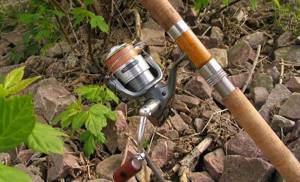
When assembling his first spinning tackle, a fisherman should focus on selecting a lightweight, high-speed spinning reel. These types of mechanisms are the easiest to operate, and they often do not require special maintenance. For many types of spinning fishing, reels in sizes from 2500 to 3500 units are suitable, with a friction brake and a spool capacity that can accommodate about 100 meters of the main thread.
A gear mechanism made of metal alloys better copes with constant loads from vigorous wiring. The gear ratio or its coefficient for spinning fishing should be higher than five. Smooth running of the reel mechanism can be ensured by the presence of 3–5 bearings. A larger number of these types of parts makes the reels heavier and more difficult to maintain. You should not rush to buy an expensive device. For the initial stage of mastering fishing, a medium-budget mechanism is sufficient.
Spinning reel
The reel is an integral part of spinning fishing. It should be said right away that it is better to buy a rod and reel together, or at least take the rod with you when buying a reel. This will allow you to find the optimal balance of the tackle, that is, concentrate the main weight in the area where the rod is gripped.
Types of coils
If you are a complete beginner angler, then first it’s worth noting that there are 3 types of reels:
- Inertial – They have not been used in spinning rods for a long time, as it is not convenient, and why, if technology does not stand still?
- Spinning reels – These reels are the most common due to ease of handling and casting distance.
- Multiplier - Quite rarely used in spinning fishing, however, they are in great demand among professional fishermen, since for the sake of their design they allow you to hold the line between the fingers and feel the most careful bites.
Beginners should only choose spinning reels, as this is a more affordable option both in terms of money and ease of handling.
Spool
It is from this part that you need to start choosing a coil. You need to consider parameters such as:
- Material of manufacture – It is best to choose metal spools, as they are more durable, and when working with braid this is especially true
- Line capacity – This parameter is good to select according to the length of the spinning rod. On reels you can often find markings 1000, 2000, etc. This means that the 1000th spool will hold 100 meters of 0.1mm line. Be careful, these numbers may vary from manufacturer to manufacturer. For a 2 meter spinning rod, a reel with a capacity of 100 meters of fishing line, 0.2 or 2000 reel, is suitable. 2.5 meters 2500, etc.
- Availability of a spare spool – This pleasant bonus will never be superfluous. For example, if you want to install a backing on the reel, because you do not have enough braid, you will need a spool when winding the line onto the reel. You can also install a monofilament line on the spare spool, which will make your tackle more versatile.
So, our spool should be metal, for the length of our spinning rod, which we chose above, size 2500 is suitable, and for the shore you can take 3000, and if the kit comes with an additional spool, it will be good, but if it is not there, then it will not work either scary.
Bearings and speed
These parameters are also quite important. Based on bearings, we can say that the more there are, the better. But if you don’t have enough money for expensive models, you need to pay attention to the location of the bearings.
Bearings must be present on:
- Line roller.
- There are reel handles on both sides of the shaft.
- On the rotor.
Since the reel in a spinning rod works constantly, these components are especially susceptible to wear.
The reel speed is selected individually, and it is difficult to recommend something universal here. A speed of 5:1 is quite suitable, but if you don’t really like to rotate the handle slowly, you can take a power reel, for example, with a gear ratio of 4:1. All these numbers are arbitrary, it can be written 5.2:1 or 4.6:1, in general 4 power and 5 speed.
Friction and inspection
The friction brake plays an important role in spinning fishing. Its correct adjustment will help protect the rod from breakage, the bait when hooking, and, of course, the trophy at the other end of the line.
The clutches are rear and front. The rear drag complicates the design of the reel, making it heavier and more bulky. The front clutch can be adjusted more precisely, but is less durable. When choosing, you need to focus on convenience.
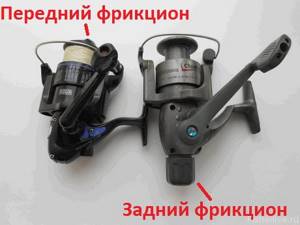
If you have previously used a rear drag, for example, in other fishing methods, then take this reel. If you have never used spinning reels at all, then choose any arrangement, it’s all a matter of habit. You should also pay special attention to the quality of materials. This is not a whim of a spoiled fisherman, but a test of authenticity.
- The inscriptions should not be erased with a finger
- There should be no visible damage on the reel in the form of scratches or chips.
- Pay special attention to all screws and screws, they should not be damaged or scratched.
Conclusion
So, for complete happiness we need:
- The reel size is 2500, and for coastal fishing you can take 3000 (according to the above characteristics of the rod).
- With a metal spool, and if there is also a spare spool, that’s totally cool.
- The reel speed can range from 4 to 5:1, and bearings must be on the line roller, the handle shaft, and the rotor.
- The friction depends on your habit, but if you have not used similar reels, then take any (I recommend the front one).
- Do not forget to inspect the reel when purchasing, there should be no scratches, and the paint should not be rubbed off with your finger.
I advise you not to skimp on the reel. Even if you don’t like this fishing method, you can change the reel at any time, for example to a Bolognese fishing rod, and enjoy its smooth action and quality.
Line and leashes
Spinning fishing can be done with either monofilament or braided fishing lines. The choice of material is determined by the fishing distance. Braided cords have a rigid, inextensible structure, which is better at attracting bites from long distances and allows you to control the course of the bait much more effectively. Monofilament fishing line, having a high stretch coefficient, does an excellent job of absorbing excess loads that arise when fighting hooked fish. But such material transmits information absolutely poorly from long distances and is mostly used for short-range fishing.
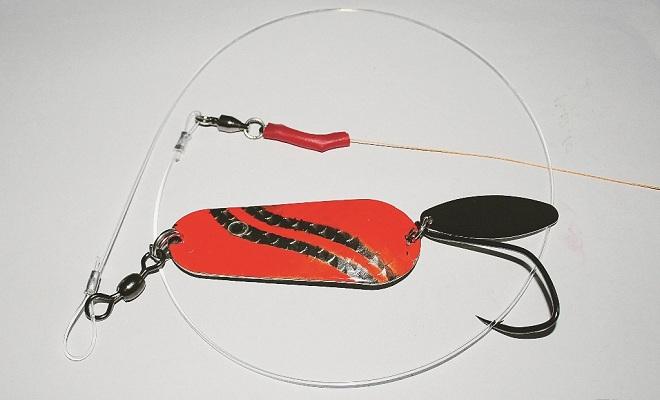
When equipping a spinning rod for fishing from the shore, preference is given to braided cords. When planning fishing from a boat, where you can approach a promising point within a short distance, it is worth considering the use of monofilament fishing lines. Braids are stronger than monofilament and their diameters in relation to breaking loads are significantly lower than monofilament wood. For rigging with braids, cords with diameters of 0.12-0.18 mm are most often used, but if you use regular nylon fishing line, you need to use a material no less than 0.2 mm thick.
Important! Such an element of equipment as a leash is used purely for catching pikes.
Modern spinning rods use soft Kevlar and fluorocarbon leaders. Steel, titanium and tungsten hard options are used much less frequently, due to their strong influence, which worsens the performance of the bait. As a rule, the optimal leash length is around 15–20 cm. In all other cases, baits are tied directly to the cord or fast-release carabiners and fasteners are used. For rotating spinners, it is necessary to have a swivel to prevent twisting and deformation of the thread.
Selection of baits

Spinning fishing is distinguished by a huge selection of artificial bait options, from which you can choose an effective and attractive tool for catching predatory and peaceful fish. The spinner's classic catching tool is the oscillating spinner. No less popular is a rotating spoon, suitable for catching most peaceful carp fish. There are a lot of silicone molds on sale that imitate fry, crustaceans, worms and fictitious fantasy types that are attractive and behave realistically when placing simulators.
The use of wobblers is no less popular in spinning hunting. Wobblers are considered a high-tech bait, endowed with the functions of maintaining a certain level of depth, having elements of a pronounced game of their own, and creating noise and vibration effects. In addition, wobblers, even with their appearance, color and body structure, arouse genuine interest among both predatory and peaceful fish.
Certain types of rigs allow you to fish with a spinning rod for live bait, frogs and dead fish. The choice of a promising bait is made based on the food preferences of the fish, its size, activity during fishing, as well as the style of fishing performed by the angler. It is recommended that a spinning player’s arsenal contain a variety of types and types of simulators, the decision to use which is made directly during the hunting process.
Lures and fishing methods
Spinning lures and fishing methods are closely related. In the last part, we chose a fast-action spinning rod; such a rod can be used to fish in all ways.
Lures
We can talk endlessly about this part of the spinning rod, and divide all the baits into classes of purpose, etc. Here we will look at 3 main types of baits:
- Spoons - Metal lures that imitate a live fish or insect, depending on the variety, cover the catching of any fish.
- Silicone baits – As the name suggests, these baits are made from silicone. They are sold in the form of artificial worms, fish, or crustaceans. Depending on the fishing method, they are used together with jig heads or put on an offset hook without loading.
- Wobblers – Plastic or wooden baits very similar to real fish. They are most often used when fishing for pike, but they also work on other fish.
All these baits should be in the spinner’s arsenal, but for those who are just mastering spinning, spinners and silicone baits will suffice.
Fishing methods
Now we’ve come to the most interesting part; now we’ll look at the most popular fishing methods. Like the types of bait, there are also 3 fishing methods:
- Flashing
- Jig
- Twitching
When trolling, fishing is done with spoons and no special skill is required. All you have to do is tie the lure to the fishing line and you can start fishing.
Jig is a little more complicated, here fishing is done directly from the bottom and bites occur precisely from the bottom. In this fishing method, it is very important to pay attention to the movement of the sagging braid, and learn to feel the bottom topography.
Twitching is a type of fishing with wobblers; in essence, it is jerking the bait. Due to the popularity and catchability of this wiring, a new direction, twitching, has appeared in spinning. For novice fishermen, this method of fishing will be quite expensive, and it is better to start mastering spinning with spinners.
Finding a promising fishing spot
Fishing with a spinning rod on a river, on a lake, or in the waters of a small pond will be successful if the fisherman knows how to correctly identify promising areas for parking and feeding fish. First of all, in a reservoir you should pay attention to visually noticeable surface anomalous areas in which there is a high probability of fish accumulation. The confluence of currents of different strengths on rivers and steep banks, the adjoining of clean water areas to the coastal walls of vegetation or overgrown areas of the reservoir, the crowns of trees hanging over the water, shading the water, always attract different species of fish and are considered promising places for fishing.
The stones and snags sticking out of the water, as well as dead wood or islands of vegetation, where an active predator will probably be hiding, are not deprived of attention. Fishing areas are near hydraulic structures, bridge supports, dams and road embankments. The activity of the trophy can be determined by the accumulation of birds in certain water areas, as well as the violent behavior of the fry jumping to the surface from the water, which is characteristic of a pike that easily reveals itself to be hunting.
For example, the asp shows its activity by frequent fighting. Echo sounders or underwater maps of fishing spots help to study the reservoir more thoroughly, and the spinning fisher himself can examine the bottom with a marker rod on the eve of the main hunt, looking for promising places for fishing. By determining the boundaries of dumps, depth differences and knowing the location of the holes, it is promising to fish on the edges of these anomalies, where predatory fish like to hunt, and especially such frequent objects of spinning fishing as pike perch and pike.
What kind of fish are caught with a spinning rod?
Theoretically, you can catch any fish with a spinning rod. The most common predators fishermen encounter are: pike, perch, pike perch, bersh, asp, catfish, trout, salmon, and brown trout. Semi-predatory chub, ide and grayling are also often bitten, and you can also catch even relatively peaceful fish: sabrefish, rudd, roach, bream, bleak. If only we had this fish in our pond...
It is clear that each fish needs its own gear and bait, and there are fewer and fewer fish in reservoirs - so in reality, spinning anglers usually catch only 1-3 “close” species of fish: pike and perch, pike perch and bersh, ide and chub... And this is still good - but sometimes they don’t catch anything... It’s not for nothing that they say that going fishing and going fishing are not the same thing...
How to cast a spinning rod
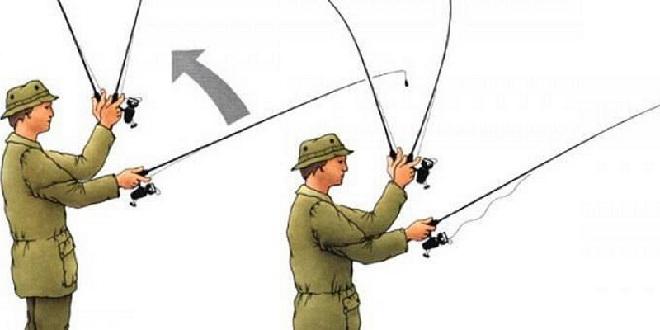
Mastering the technique of using a spinning rod for a novice angler begins with practicing throws. In fact, working with the tackle is not that difficult, but it requires preliminary training, where the spinner can understand and practice the principles of the harmonious operation of a set of equipment. It is best to carry out training in an open, free and clean area. There are three main methods of casting a spinning bait: casting from the back, casting from under the hand and casting from the side. Casting from the back is the most commonly used method of presenting bait .
Important! The method is distinguished by its range and accuracy of sending the simulator.
It is most often used when fishing from the shore, when trees and bushes adjacent to the banks do not interfere with the swing. The spinning rod is taken in both hands. The line guide of the reel opens, and the cord is pressed against the tackle form with the finger of the right hand. The bait being thrown descends from the tip of the tackle by 30–40 cm. The rod is placed behind the back and a smooth swing is made. At the highest point of the amplitude of the swing, the finger releases the cord, which, by inertia, from the force of the bait fed forward, is thrown off the reel spool. After splashing down the bait, the fishing line closes and retrieving begins.
Read more about the technique of casting a spinning rod.
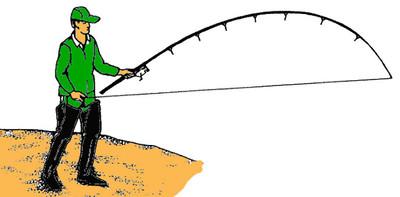
The rod with the hanging bait is moved in the opposite direction from the hand holding it, going down slightly. The finger holds the line on the blank when the line guide is open. A sharp movement of the rod is made forward, short, with the tip of the spinning rod raised and the line released synchronously. According to the feeding distance, the bait is slowed down for splashdown by lightly pressing the cord with your finger in the right place, followed by throwing it into the working position of the line layer. Side casting is used in the technique of catching predators with a spinning rod in cramped conditions, when the coastlines are covered by tree crowns or bushes and tall reeds that interfere with casting from the back. The rod is moved horizontally towards the hand holding it, to the side. A smooth swing is made with the simultaneous release of the pressed fishing line with the line guide open. The bait flies far, but often not so accurately, which must be taken into account when carrying out this type of casting.
Spinning fishing technique for beginners
To properly fish with a spinning rod, an angler needs to master several basic types of fishing and be able to use them under conditions suitable for fishing tactics. The quality of the wiring itself will depend on the proper balance of the rod and the weight of the bait in conjunction with the fishing depth and current forces. Wires carried out in reservoirs without currents or with little current are much easier to do than fishing on a fast river. Current forces influence the operation of the simulator, distorting its trajectories and level horizons, which is taken into account when selecting baits with a test that can quickly bring the tool to operating parameters without overloading the form itself. During wiring, they carefully monitor the movement of the quivertype and their own tactile sensations, reacting to the failure of the simulator with short jerks and sharp cuts.
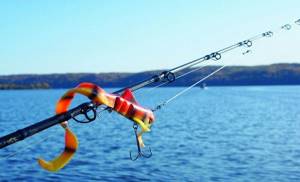
Important! Any malfunction of the fishing tool is fraught with a bite from cautious and suspicious fish, requiring a reverse reaction from the spinning angler.
Having felt the resistance of prey hooked, you need to calmly begin fishing, trying to keep both the catch and the tackle itself intact.
Stepped type of wiring
The stepped type of retrieve is the most productive method in spinning hunting. It is used in most cases when fishing is carried out with silicone. The technique for holding the nozzle is quite simple. After the simulator is deepened, the spinning player begins reeling in the cord with two or three turns of the reel handle, pausing. During the revolutions of the mechanism, the silicone lifts off the ground, making a kind of step in the water column, and during a pause it falls completely freely back to the bottom. This kind of jig for beginners helps them develop their own fishing tactics based on maintaining different pause times, speed and number of reeling revolutions. The line is suitable for catching pike, pike perch, perch and catfish. Bycatch can include bream, carp, carp and crucian carp.
Uniform wiring
The uniform wiring method is much simpler than the stepped type of feeding the simulator. This is a classic type of fishing with a rotating lure, used to catch all types of predatory and peaceful fish. In addition to spinners, they fish on a uniform retrieve with wobblers and unloaded silicone. The wiring technique is quite simple. The spinner brings the fishing tool into the hunting zone and, when it reaches the working horizon, begins winding the cord at the same speed. During the process of winding the threads, the failure of the simulators is monitored by cutting. As a rule, the technique does not imply pausing and is characterized only by changing the speed of the bait during the next cast, which depends on the activity of the fish.
Important! Aggressive fish take at fast speeds, passive fish prefer to attack a sluggish bait.
In practice, spinning anglers often have to combine styles, deviating from the classical rules. Often, uniform movements with changing speeds and wave movements of spinners or wobblers are successful. In other situations, the predator likes to pause and attack the bait hanging in the water column.
Fishing
Successful fishing with a spinning rod ends with a pleasant moment for the angler, namely fishing. The bite is accompanied by an immediate hook, a sharp, but not sweeping, movement as short as possible. If you feel the weight on the hook, you should not rush, forcing events, pulling the fish to the shore or side of the boat.
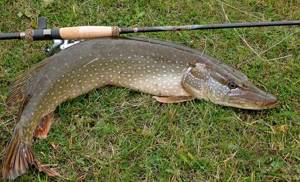
It’s good when fishing with a wobbler contributed to your luck and two or even three hooks dug into the predator’s mouth and securely held it on the rod. It’s another matter when the lure with one hook from the outside of the mouth or by the tip of the lip grabbed a lively pike, producing tall candles and aggressive waste during fishing. At such moments, the angler’s concentration and constant tension on the line help to cope with any fish. A particularly large trophy is pumped out using a fishing rod and winding the released fishing line with a reel. When fishing from boats, they always keep a landing net with them, which they use to pick up fish brought to the side. When fishing from coastlines, they look for comfortable and flat banks where they can bring caught fish with the possibility of further removing them from the water to land.
Basic equipment elements
It is important for a novice spinning angler to prepare for the first active fishing in his life. The main stage of this action is the assembly of the gear. It’s good if a spinning fishing neophyte has a good, knowledgeable friend who is ready to enlighten him about the equipment, because there are no trifles in this matter.
This bait provides a rich catch even with a bad bite! Read more An incorrectly selected rod or reel can not only minimize the likelihood of catching the coveted trophy, but also kill the pleasure of fishing in general. Each cast is a physical action, quite difficult if you are not used to it. It is not without reason that some enthusiastic beginners, after their first fishing trip, lose the ability to perform at least some actions with their right hand for several days. Your hand will hurt even with perfectly selected equipment, but the consequences will not be so catastrophic.
So, we begin to assemble the first spinning rod in our lives. the following equipment in the store
- spinning rod,
- spinning reel,
- fishing line (main and for leash),
- set of baits.
Now we will deal with each of the elements and try to assemble all the equipment into a single whole.
Rod

The main (and most expensive) element of spinning equipment is a special fishing rod. Let's figure out what parameters to choose it by:
- Length . In this case, you should know the fishing conditions and the required casting distance. On large reservoirs and deep rivers, blanks of maximum length are used; when fishing in thickets or from a boat, shorter rods (from 2.1 m in length) are used.
- Test . The rod test is directly dependent on the expected weight of the bait. To begin with, you can focus on the middle class (bait weight - 10-30 grams) - it is the most versatile. But subsequently it is better to have at least two equipped forms in your arsenal: for “light” and “heavy” baits.
- Build . Another very important characteristic is the structure of the rod (its flexibility). The system can be super-fast, fast, medium, slow. For a beginner, it is better to take a form (whip) with a fast action: it makes it easier to carry out postings and to react faster to bites.
- Build type . For transportation, telescopic models are undoubtedly more convenient: when folded, they fit into ordinary bags. Plug rods take up a little more space, but when fishing directly, spinning rods of this type are much more reliable.
- Rings . The rings must be securely fastened and not have any irregularities that could cause chafing of the fishing line. Particular reliability of the rings is required when using a braided cord.
- Handle . The handles of cheap fishing rods are made from all kinds of artificial polymer materials. However, for the first fishing in your life (as well as subsequent ones), it is better to choose a rod with a handle made of natural cork: although it is more expensive, it is more comfortable to use.
- Material . The material determines both the weight and strength of the fishing rod. In this regard, we can recommend composite and carbon blanks: they demonstrate the optimal combination of low weight and high strength.
Coil
The next important element of the equipment is the reel, which is attached to the fishing rod. There are inertia-free and multiplier models . For our purposes, spinning reels are optimally suited, while multipliers are indispensable for trolling and trophy fishing. Even a beginner can handle a spinning rod: neither installing it on a rod, nor setting it up, nor using it while fishing presents any particular problems.
Reels 2000-3000 are considered the most universal (the size is calculated by the footage and the diameter of the fishing line that fits on the spool). Another important point is the number of bearings, of which there can be up to 12 in the mechanism. 5-6 bearings are quite enough - this ensures sufficient smoothness and reliability of the mechanism.
Not all reels are equipped with friction brakes; when fishing for small specimens, they are not really needed. But what if on your first fishing trip you hook a large predator? This possibility cannot be ruled out, so it is better to choose a version with a friction brake , which automatically fixes the unwinding of the fishing line. In this case, you need to take the time to adjust the brake. To do this, it is enough to firmly fasten the fishing line to some object, move away from it a couple of steps and, having secured the brake, tighten the fishing line as much as possible. Once the maximum tension is reached, the clutch is gradually released until the line is released.
The reel is attached to the spinning rod using a nut, which must first be unscrewed until the mount reaches the required diameter, then tightly tightened directly onto the rod.
Some fans of the old school use old-style inertial reels when fishing with spinning rods. This has its advantages: light weight of the coil, better sensitivity when wiring. However, this option should not be recommended for beginners: you will quickly get tired when casting.
fishing line

There is no friend to taste and color, and there is no universal fishing line suitable for all types of rods and all kinds of fishing conditions. Spinners prefer two types of fishing lines: monofilament threads and braided cords.
Monofilament fishing line is a nylon thread; it is a classic option that is used in any gear, including spinning rods.
It is inexpensive, not too noticeable in water, and with the correct choice of diameter and manufacturer, it demonstrates sufficient strength. The monofilament stretches slightly in water under load, which can be regarded as an advantage (it absorbs and reduces the load on the whip) and as a disadvantage (it does not allow an immediate response to a bite). Braided cord , consisting of several strands, is approximately twice as strong as monofilament fishing line and practically does not stretch under the influence of loads, which helps to instantly transfer the bite to the tip of the blank.
Braided cords are much more expensive, richer in color, but are not particularly durable: with frequent casting, they fray and damage the rings. Cords are indispensable for trophy fishing, but for a beginner it is still better to limit yourself to monofilament. When spinning fishing, not only the main line is used, but also a leash, which is attached to it using swivels and carabiners. You can simply tie it on, but this is not very convenient: it is difficult to change leashes, and they will get tangled more often.
In most cases, it is recommended to use fluorocarbon leaders : they are quite durable and unnoticeable in the water. To catch large pike, semi-rigid and hard metal leashes : it simply bites fluorocarbon. Based on this, it is worth having several leashes for different purposes in stock, but at first you can get by with a couple of fluorocarbon ones.
Lures
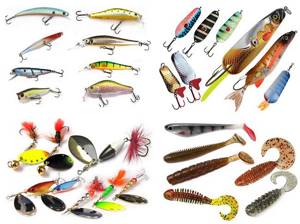
Choosing bait is a headache for most spinners. In most cases, all kinds of artificial baits are used, fortunately, there is no longer any urgent need to make them with your own hands, as fishermen did in Soviet times. Modern industry produces a lot of models for various types of fishing, rod testing, fishing conditions, type of intended prey, and so on. If you are not too limited in funds, definitely choose lures from trusted manufacturers: you will not have problems with wiring or hook strength.
All artificial baits for spinning fishing can be divided into three types:
- Spoons . Classic spoons are divided into two broad types: rotating and oscillating. All new products such as castmasters and spinnerbaits are variations of traditional spinners. Different types of spoons require different fishing tactics and are intended for certain types of fish, which is usually indicated on the packaging.
- Wobblers . Here we have quite modern baits made from artificial polymers. Outwardly, they resemble small fish, and playing with a rod allows them to behave naturally in the water. There are many variations of wobblers with their own names (poppers, walkers and others like them), which behave differently when retrieved. These baits are ideal for twitching and are highly catchable, but require some skill when retrieving. They should not be recommended to beginners.
- Silicones . Twisters and vibrotails are new, but rapidly gaining popularity, silicone baits. They are not as durable as the above-mentioned ones, but they do not require special skills and behave naturally even with not very skillful wiring. They are perfect for the simplest jig, which allows you to catch fish at any depth, however, for near-bottom wiring, equipment with a retractable leader is required. A variation of silicone is artificial rubber - the same material, supplemented with a flavor that is tempting to predators.
When catching a small predator, for example, grass perch or pike perch, you can also use bait of animal origin (for example, an ordinary worm or wood grub).
